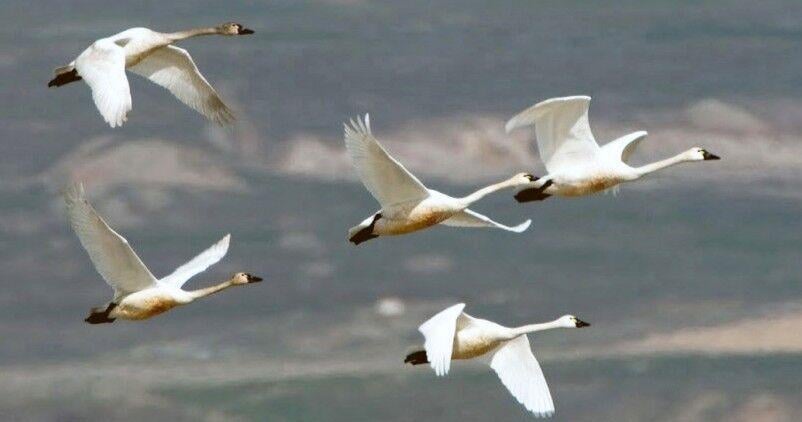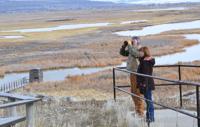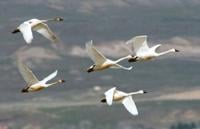BRIGHAM CITY – Migrating swans will be stopping to rest in two areas in Box Elder County in March. Every year the majestic bird can be seen at Compton’s Knoll at the Division of Wildlife Resources Salt Creek Waterfowl Management Area and at the Bear River Migratory Bird Refuge.
A couple watching for swans at the Division of Wildlife Resources Salt Creek Waterfowl Management Area recently.
Their spring migration takes them from wintering grounds in California to nesting sites in Canada and Alaska.
“Because of their large size, swans are amazing birds to see in flight,” Utah Division of Wildlife Resources Northern Region Outreach Manager Mark Hadley said. “You’ll have no problem spotting them — they’re huge and almost pure white in color.”
Swans are just one of the many unique bird species that migrate through Utah each year.
Compton’s Knoll viewing area is a small hill on the southeast side of the DWR’s Salt Creek Waterfowl Management Area where swans and other birds can be found. The small hill is above the marsh and provides great viewing opportunities.
To get a better look at the birds, bring binoculars or a spotting scope. There are two bird-viewing blinds that are also located at the bottom of the hill.
The Salt Creek WMA is about 12 miles northwest of Corinne.
The other viewing area managed by the U.S. Fish and Wildlife Service, is the Bear River Migratory Bird Refuge Auto Tour Route. It is located about 12 miles west of Brigham City.
To reach the auto tour route, exit I-15 at exit 363, and travel west on West Forest Street to a large parking area with an observation tower. Stop at the tower to look for swans in the marsh to the north. Visitors can then drive along the 12-mile auto tour route a journey through the heart of the refuge. There should be thousands of swans along the driving route.
There are two types of swans that migrate through Utah during different times of the year: tundra and trumpeter swans. Both swan species stop in Utah’s wetlands for some much-needed rest and refuel during their migration north in the spring.
Trumpeter swans are the largest waterfowl species in North America, with wingspans exceeding 8 feet and are significantly larger than tundra swans. Trumpeter swans also do not have a yellow-colored spot near their eyes which is a defining characteristic of tundra swans.

A group of swans take flight in the Bear River Migratory Bird Refuge.
Trumpeter swans make a distinctive trumpet-like sound, hence their name. Their spring migration takes them from wintering grounds in California to nesting sites in Canada and Alaska.
While the peak time to see them in the spring is typically March, you can also see swans in Utah during their fall migration as well, typically in early-to-mid November.
Visitors can sometimes see migrating swans at the DWR’s George S. and Dolores Eccles Wildlife Education Center and Hasenyager Preserve. The DWR’s Eccles Wildlife Education Center is part of the Farmington Bay Waterfowl Management Area.



